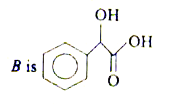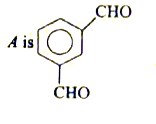An organic compound (A) on treatment with acetic acid in the presence of sulphuric acid produces an ester (B). (A) on mild oxidation gives (C),(C) with 50% potassium hydroxide followed by acidification with dilute hydroxide acid generates (A) and (D),(D) with phosphorus pentachloride followed by reaction with ammonia gives (E),(E) on dehydration produces hydrocyanic acid. Identify the compounds (A),(B),(C),(D), and (E).
To solve the problem step by step, we will identify each compound (A), (B), (C), (D), and (E) based on the reactions described.
Step 1: Identify Compound (A)
The question states that an organic compound (A) on treatment with acetic acid in the presence of sulfuric acid produces an ester (B). This suggests that (A) is likely an alcohol, as alcohols react with carboxylic acids to form esters.
Assumption: Let’s assume (A) is methanol (CH₃OH).
Step 2: Identify Compound (B)
When methanol reacts with acetic acid (CH₃COOH) in the presence of sulfuric acid, an ester is formed. The reaction can be represented as:
\( \text{CH}_3\text{OH} + \text{CH}_3\text{COOH} \rightarrow \text{CH}_3\text{COOCH}_3 + \text{H}_2\text{O} \)
Thus, compound (B) is methyl acetate (CH₃COOCH₃).
Step 3: Identify Compound (C)
The problem states that (A) on mild oxidation gives (C). Since we assumed (A) is methanol, mild oxidation of methanol produces formaldehyde (HCHO).
So, compound (C) is formaldehyde.
Step 4: Identify Compound (D)
Next, (C) (formaldehyde) reacts with 50% potassium hydroxide (KOH) followed by acidification to generate (A) and (D). Since formaldehyde has no alpha hydrogen, it undergoes the Cannizzaro reaction, producing an alcohol and a carboxylic acid.
Thus, (A) is methanol, and (D) is formic acid (HCOOH).
Step 5: Identify Compound (E)
The problem states that (D) (formic acid) with phosphorus pentachloride (PCl₅) followed by reaction with ammonia produces (E).
Formic acid reacts with PCl₅ to form formyl chloride (HCOCl), which then reacts with ammonia to produce formamide (HCONH₂).
Thus, compound (E) is formamide.
Step 6: Final Identification of Hydrocyanic Acid
Finally, the problem states that (E) on dehydration produces hydrocyanic acid (HCN). Formamide can be dehydrated to yield hydrocyanic acid.
Summary of Compounds:
- (A) = Methanol (CH₃OH)
- (B) = Methyl acetate (CH₃COOCH₃)
- (C) = Formaldehyde (HCHO)
- (D) = Formic acid (HCOOH)
- (E) = Formamide (HCONH₂)
The question states that an organic compound (A) on treatment with acetic acid in the presence of sulfuric acid produces an ester (B). This suggests that (A) is likely an alcohol, as alcohols react with carboxylic acids to form esters.
When methanol reacts with acetic acid (CH₃COOH) in the presence of sulfuric acid, an ester is formed. The reaction can be represented as:
The problem states that (A) on mild oxidation gives (C). Since we assumed (A) is methanol, mild oxidation of methanol produces formaldehyde (HCHO).
Next, (C) (formaldehyde) reacts with 50% potassium hydroxide (KOH) followed by acidification to generate (A) and (D). Since formaldehyde has no alpha hydrogen, it undergoes the Cannizzaro reaction, producing an alcohol and a carboxylic acid.
The problem states that (D) (formic acid) with phosphorus pentachloride (PCl₅) followed by reaction with ammonia produces (E).
Finally, the problem states that (E) on dehydration produces hydrocyanic acid (HCN). Formamide can be dehydrated to yield hydrocyanic acid.
- (A) = Methanol (CH₃OH)
- (B) = Methyl acetate (CH₃COOCH₃)
- (C) = Formaldehyde (HCHO)
- (D) = Formic acid (HCOOH)
- (E) = Formamide (HCONH₂)
Topper's Solved these Questions
- BOOK - CENGAGE CHEMISTRY ENGLISHCHAPTER - CARBOXYLIC ACIDS AND THEIR DERIVATIVESEXERCISE - Exercises Archives (True/False)2videos
CARBOXYLIC ACIDS AND THEIR DERIVATIVES
- BOOK - CENGAGE CHEMISTRY ENGLISHCHAPTER - BIOMOLECULESEXERCISE - Exercises Archives (Analytical And Descriptive)8videos
BIOMOLECULES
- BOOK - CENGAGE CHEMISTRY ENGLISHCHAPTER - CHEMICAL KINETICSEXERCISE - Archives Subjective23videos
CHEMICAL KINETICS
Similar Questions
Knowledge Check
- Question 1 - Select One or More
Compound (A) C8H6O2 on treatment with aq. NaOH followed by acidification gives (B) C3H2O3 which on oxidation gives benzoic acid only:
A B
B C
C D
D
An organic compound 'A' on treatment with KCN gave another compound B which on hydrolysis with dil. HCI gave acetic acid. Identify A.
View SolutionGive equations for the reaction of acetic acid with potassium hydroxide
View SolutionAn aliphatic hydrocarbon A on treatment with sulphuric acid in the presence of HgSO4 yields a liquid B with molecular formula C2H4O. Bon oxidation with acidified potassium dichromate yields C which gives effervescence with sodium bicarbonate. C when treated with SOCl2 gives D. When D reacts with ethanol it gives a sweet smelling liquid E. E is also formed when C reacts with ethanol in the presence of conc. H2SO4.
Identify A, B, C, D and E.View SolutionWrite the reaction between aluminium hydroxide and dilute sulphuric acid
View Solution(i) An organic compound A with molecular formula C7H8 on oxidation by chromyl chloride in the presence of CCl4 gives a compound B which gives positive Tollen's test. The compound B on treatment with NaOH followed by acid hydrolysis gives two product C and D. C on oxidation gives B which on further oxidation gives D. the compound D on distillation with sodalime gives a hydrocarbon E. Below 60∘C, concentrated nitric acid reacts with E in the presence of concentrated sulphuric acid forming a compound F. identify the compounds A,B,C,D,E and F.
(ii) Give chemical test to distinguish : Formaldehyde and acetaldehyde.View SolutionAn organic compound (A) on treatment with ethyl alcohol gives a carboxylic acid (B) and compound (C). The hydrolysis of (C) under acidic conditions gives (B) and (D). Oxidation of (D) with KMnO4 also gives (B). (B) on heating with Ca(OH)2 gives (E) (molecular formula, C3H6O). (E) does not give Tollens test and does not reduce Fehling's solution but forms a 2,4−dinitrophenyl hydrazone. Identify (A),(B),(C),(D), and (E).
View SolutionA halogen compound 'A' on hydrolyses with dilute alkali followed by acidification gives acetic acid. The compound X is:
View Solution

